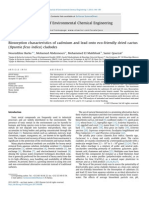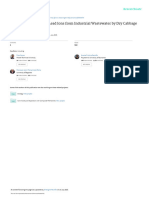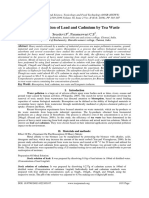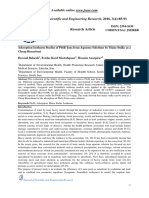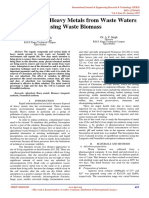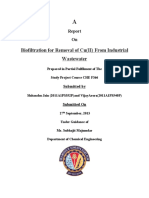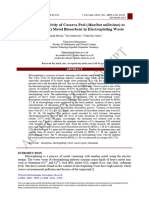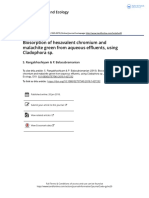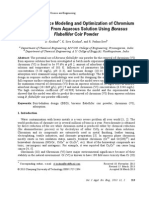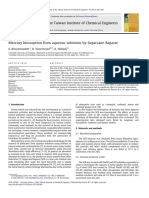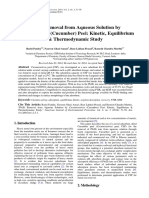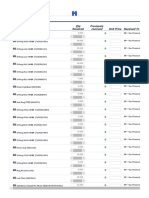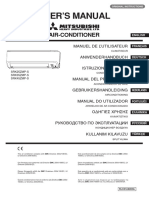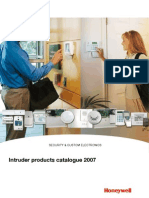Optimization of Process Parameters For Biosorption of Chromium Using Green Algae
Optimization of Process Parameters For Biosorption of Chromium Using Green Algae
Uploaded by
editorijaiemCopyright:
Available Formats
Optimization of Process Parameters For Biosorption of Chromium Using Green Algae
Optimization of Process Parameters For Biosorption of Chromium Using Green Algae
Uploaded by
editorijaiemOriginal Title
Copyright
Available Formats
Share this document
Did you find this document useful?
Is this content inappropriate?
Copyright:
Available Formats
Optimization of Process Parameters For Biosorption of Chromium Using Green Algae
Optimization of Process Parameters For Biosorption of Chromium Using Green Algae
Uploaded by
editorijaiemCopyright:
Available Formats
International Journal of Application or Innovation in Engineering & Management (IJAIEM)
Web Site: www.ijaiem.org Email: editor@ijaiem.org, editorijaiem@gmail.com Volume 2, Issue 6, June 2013 ISSN 2319 - 4847
Optimization Of Process Parameters For Biosorption Of Chromium Using Green Algae
V.Gayatri Valli1, G.H.Rao2, V.Sridevi3, K.V.Keerthi4
1
M.Tech, Center for Biotechnology, Dept of Chemical Engineering, Andhra University, A.P, India, 2 Professor, Department of Chemical Engineering, ANITS 3 Associate professor, Dept of Chemical Engineering, Andhra University, A.P, India, 4 M.Tech, Center for Biotechnology, Dept of Chemical Engineering, Andhra University, A.P, India,
ABSRACT
Heavy metals are in various industries due to technological importance and waste water from these industries include metal ions having a permanent toxic effect. Biotechnology has been investigated as an alternative method for treating the metal containing waste water of low concentration. The aim of the study is to examine the possibility of using green algae to biologically remove chromium of low concentration waste water. Preliminary investigations will be carried out to find out the range of process variables: contact time, adsorbent dosage, initial metal concentration, pH of the solution at which reasonable amount of metal will be adsorbed on the adsorbent. Kinetics and equilibrium studies will be carried out to find out the order of kinetics and the suitable adsorption isotherm, respectively.
Keywords: Biosorption, Chromium, Green algae, Kinetics, Adsorption Isotherms.
1. INTRODUCTION
Water pollution is by various toxic substances, chemicals, thermal pollution etc. It causes ecological imbalance. Water pollution because of heavy metals (chromium VI) is of major concern now-a-days, as it is affects the environment and leading to increase in environmental pollution[2]. It mainly affects the aquatic ecosystem. Aquatic system is under increasing stress because of increase in population, technological development, urbanization and economic growth. Aquatic organisms are under high risk of contamination. Increased urbanization and the drinking water demand in areas of industrial activity have increased the attention paid to this problem metal. Improper handling and or discharge into local sewers and the environment creates the potential for contamination of drinking water sources. The presence of chrome in potable drinking water sources has the potential to cause damage to liver, kidney, circulatory and nerve tissues and skin irritation from long-term exposures at levels above the Maximum Contaminant Level (MCL).Chromium (VI) is more toxic than the other forms. It is toxic even if it is present in lower concentrations i.e. in the range of 0.1 10 mg/L. According to the Indian Standards[3], the permissible limit of Cr(VI) is 0.05 and 0.1 mg/L for portable and industrial discharge water respectively. Various conventional techniques like reverse osmosis, electrodialysis, ultrafiltration, chemical precipitation etc. Various other techniques like ion-exchange, phytoremediation, chemical reduction, xanthate process [10], solvent extraction, membrane process, evaporators, cementation, and electrodeposition. The disadvantages of conventional processes are i) expensive ii) not eco-friendly iii) dependent on the concentration of waste. To overcome these disadvantages we have newer technologies like biosorption [8]. Biosorption processes, defined as the sorption of the metal ions by biomass, are being employed as an alternative technique for the decontamination of the industrial effluents and for the recovery of the retained metals [9].Different types of biomass have been used for the clean-up of industrial effluents, such as: algae, bacteria, fungi and yeasts[6] or even extracellular material as exopolysaccharides [7]. Modeling the equilibrium data in terms of adsorption isotherms is crucial for designing the industrial biosorption process equipment. To examine the relationship between sorbed metal concentration (qe) and aqueous concentration at equilibrium, isotherms like Langmuir and Freundlich are widely used [4,5]. In this paper we have studied the capability of green algae as the biosorbent for the biosorption of chromium (VI) and optimized the process parameters like contact time, pH, adsorbent dosage, metal concentration.
2. MATERIALS AND METHODS BIOSORBENT PREPARATION:
The green colored marine algae was used in the present study. It was collected from the Visakhapatnam beach. The collected algae were was deionized water several times to remove impurities. The washing process continued till the wash water contained no dirt. The washed algae was then completely dried. The dried algae was then powdered using domestic mixer. In the present study the powdered materials of uniform particle size were then directly used as sorbents without any pre-treatment. The processed algae equivalent to 0.5g dry weight was added to 100ml of an aqueous solution of chromium (pH 2.0 adjusted with HCl) of required concentration. The concentration of the unabsorbed chromium was determined spectrophotometrically at 540nm using diphenylcarbazide reagent. The effect of several
Volume 2, Issue 6, June 2013
Page 142
International Journal of Application or Innovation in Engineering & Management (IJAIEM)
Web Site: www.ijaiem.org Email: editor@ijaiem.org, editorijaiem@gmail.com Volume 2, Issue 6, June 2013 ISSN 2319 - 4847
parameters such as contact time, pH, adsorbent dosage, metal concentrations on adsorbtion is studied. The pH of the chromium aqueous solution is adjusted using HCl/ NaOH.
Preparation of metal solutions :
Metal concentrations are prepared by dissolving in potassium dichromate and in double distilled water to get metal concentrations of 5, 10, 15, 20, 25 mg/L. A stock solution of 1000 mg/L was prepared and all other concentrations were obtained from it. To the stock solution add 5ml of nitric acid(1:1). BIOSORPTION EXPERIMENT: Different concentrations of biomass were combined with 100ml of metal solution in 250ml conical flask. The flasks were placed on a shaker with a constant speed of 150 rpm and left to equilibrate. Samples were collected at predefined intervals, centrifuged at 5000g for 2min and the amount of metal in the supernatant was determined spectrophotometrically at 540nm using diphenylcarbazide reagent. ANALYTICAL ESTIMATION OF CHROMIUM : A 0.25% w/v solution of diphenylcarbazide was prepared in 50% acetone. 15ml each of the sample solutions, containing various concentrations of Cr (VI) were pipette out into 25ml standard flasks. To this 2ml of 3M H2SO4, was added followed by 1ml of diphenylcarbazide and the total volume was made up to 25ml using deionized, double distilled water. Chromium concentration estimated by the intensity of colour complex formed was measured using UVvisible spectrophotometer. The absorbance was measured against a reagent blank at maximum wavelength of 540 nm. A linear plot was obtained indicating adherence to the beer Lamberts law in the concentration range was studied.
3. RESULTS AND DISCUSSION
In the present study green algae was used for the biosorption of chromium. The parameters affecting the biosorption were studied. The effect of each parameter was discussed below. Effect of contact time: The adsorption experiments of biosorption capacity increased with increase in time. The equilibrium time was 30 min.chromium were carried out for different contact times with fixed adsorbent dose of 5 g/L, initial metal concentration of 50 mg/L, pH at 2.0 and at a temperature of 37C. The results were plotted in Figure1.
Figure 1 : Effect of time on % removal of Chromium
Effect of pH: The pH value of the solution is an important factor that controls the biosorption of chromium. Figure 2 shows the pH of highest biosorption capacity at 2.0. with the increase in the pH there was gradual decrease in the pH was observed.
Figure 2: Effect of pH on % removal of Chromium
Volume 2, Issue 6, June 2013
Page 143
International Journal of Application or Innovation in Engineering & Management (IJAIEM)
Web Site: www.ijaiem.org Email: editor@ijaiem.org, editorijaiem@gmail.com Volume 2, Issue 6, June 2013 ISSN 2319 - 4847
Effect of adsorbent dosage: As shown in Figure 3, to achieve maximum biosorption capacity for the biosorbent of chromium the adsorbent dosage was varied between 1 to 7 g/L and it was found that a concentration of 5 g/L was sufficient for the maximum biosorption of chromium.
Figure 3 : Effect of adsorbent dosage on % removal of Chromium Effect of metal concentration : As shown in Figure 4, the effect of metal concentration was studied by varying metal concentrations from 50 to 80 mg/L with fixed adsorbent dosage of 5 g/L, contact time of 30 minutes and pH at 2.0. it was found that with increase in the metal concentration there was increase in the biosorption capacity. The biosorption capacity was increased up to 52% .
Figure 4 : Effect of metal concentration on % removal of Chromium
Adsorption kinetics :
Pseudo first order and pseudo second order models are tested to investigate the kinetic mechanism. Kinetic data were obtained at intervals of 2, 5, 10, 15, 20, 25, 30 minutes starting with initial metal concentration 50mg/L, biosorbent dosage 5g/L and pH value of 2. Equilibrium was obtained at 30 minutes. Pseudo first order is expressed as dq/dt = K1(qe q) (4.1) whereqe is the amount of chromium adsorbed at equilibrium (mg/g of adsorbate) , q is the amount of metal adsorbed at various times and K1 is the first order adsorption rate constant (min -1). After applying the limits q = 0 at t = 0; q = qe at t = t; the integrated form of equation (4.1) becomes log(qe q) = log (qe) K1t..(4.2) and the corresponding plot is presented in Figure 5. As the straight line is not passing through all the experimental data it is concluded that the rate of chromium removal by green algae adsorbate does not follow the pseudo first order equation. From the linear regression the following coefficients are obtained : qe = 8.4152 K1 = 0.16247 the non-linear form of integrated equation for first order kinetics is given by q = qe (1 exp (-K1t)) ..(4.3) non-linear regression of equation (4.3) yielded the following parameters : qe = 5.9076 K1 = 0.12208
Volume 2, Issue 6, June 2013
Page 144
International Journal of Application or Innovation in Engineering & Management (IJAIEM)
Web Site: www.ijaiem.org Email: editor@ijaiem.org, editorijaiem@gmail.com Volume 2, Issue 6, June 2013 ISSN 2319 - 4847
I Order Plot 1.5 1
log(Dye ads. at equil - Dye adsorbed)
0.5 0 -0.5 -1 -1.5 -2 -2.5
10
15 time in minutes
20
25
Figure 5 : First order kinetics Pseudo second order model: It predicts the sorption capacity of the solid phase over the entire range of data. Furthermore, it is in agreement with chemisorptions being the rate controlling step and is expresses as dq/dt = K2 (qe q)2.(4.4) where K2 is the second order rate constant with units of g/mg.min. with the integration limits of same as in the previous case, the integrated linear form of equation (4.4) becomes t/q = 1/k2qe2 + t/qe ..(4.5) The plot of equation 5 resulted in a good straight line as shown in Figure 6. From the linear fit, the following coefficients are obtained : qe = 7.408 K2 = 0.016965 the non-linear form of integrated equation for second order kinetics is given by q = qe2 K2t /(1+qe2K2t) ..(4.6) and the non-linear regression of equation(5.6) gave the following values qe = 7.3706 K2 = 0.017258 q values as estimated by equations (4.3) and (4.6) at various time intervals for I order and II order kinetics respectively, are compared with the experimental values . Second order kinetics gave a reasonable fit with coefficient of determination R2 being equal to 0.98287.
II Order Plot 5.5 5 4.5
time/Conc.Metal adsorbed
4 3.5 3 2.5 2 1.5
10
15 20 time in minutes
25
30
Figure 6: II order kinetics
Adsorption isotherms : To examine the relationship between sorbed metal concentration (qe) and aqueous concentration at equilibrium, isotherms like Langmuir and Freundlich are widely used. To get equilibrium data, initial metal concentration were varied from 10 to 70 mg/L while the adsorbent dosage (5g/L), pH (2), contact time (30 min) were kept constant. The
Volume 2, Issue 6, June 2013
Page 145
International Journal of Application or Innovation in Engineering & Management (IJAIEM)
Web Site: www.ijaiem.org Email: editor@ijaiem.org, editorijaiem@gmail.com Volume 2, Issue 6, June 2013 ISSN 2319 - 4847
results are shown in Table 1. Two different isotherms are fitted to the data and the resulting equations with their estimated coefficients are shown in Figure 7.
Table 1 : Adsorption isotherms
s.no. 1 2 3 4 5 6
Co 10 20 40 50 60 70
Ce 0.54 1.54 6.62 12.22 18.21 24.02
q (expt.) 1.8920 3.6920 5.0560 5.5570 5.6700 5.9960
q (Freundlich) 2.5816 3.2974 4.6834 5.3485 5.8707 6.2628
q (Langmuir) 1.9950 3.5447 5.2601 5.5963 5.7543 5.8356
6
Conc. of metal adsorbed on biomass
5 Freundlich Langmuir Experimental
5 10 15 20 Concentration of metal solution at equilibrium
25
Figure 7 : comparison of adsorption isotherms
CONCLUSION:
The biomass of green algae was found to be a potential low-cost adsorbent for the removal of chromium from water with a biosorption removal capacity of 75%.The sorption of chromium on green algae was found to follow Langmuir adsorption isotherm. The sorption of chromium followed the second order kinetic model which is based on the assumption of biosorption as the rate limiting step.
REFERENCES:
[1.] N.Ahalaya , T.V.Ramachandra , R.D.Kanamdi, Biosorption of chromium (VI) from aqueous solutions by the husk of Bengal gram (Cicer arientinum), Electric journal of biotechnology, pp. 1-3,2006. [2.] T.Angelidis, K.Fytianos, G.Vasilikiotics, Lead removal from wastewater by cementation utilising a fixed bed of iron spheres,Environmental Pollution,(50), pp.243-251,1988. [3.] S.S.Baral, S.N.Das, P.Rath, Hexavalent Chromium removal from aqueous solution by adsorption on treated sawdust, Biochem.Eng. J,(13), pp.216-222,2006. [4.] Erhan Demirbas, K.Mehmet, S. Elif, O.Tuncay, Adsorption kinetics for the removal of chromium (VI) from aqueous solutions on the activated carbons prepared from agricultural wastes, 30 ( 4), pp. 533-539,2004. [5.] G.M.Gadd, Bioremedial potential of microbial mechanisims of metal mobilization and immobilization, Current Opinion in Biotechnology, (11), pp. 271-279,1999. [6.] N.Kuyucak, B.Volesky, Biosorbents for recovery of metals from industrial solutions,Biotechnology Letters, (10), pp.197-142,1988.
Volume 2, Issue 6, June 2013
Page 146
International Journal of Application or Innovation in Engineering & Management (IJAIEM)
Web Site: www.ijaiem.org Email: editor@ijaiem.org, editorijaiem@gmail.com Volume 2, Issue 6, June 2013 ISSN 2319 - 4847
[7.] M.Loaecm, R.Oliver, J. Guezennece, Uptake of lead, cadmium and zinc by a noble bacterial exopolisaccharide, Water Research, (31), pp. 1171-1179,1997. [8.] Tarangini, Biosorption of heavy metals using individual and mixed cultures of Pseudomonas aeruginosa and Bacillus subtilis,pp.1-77,2009. [9.] B.Volesky, Sorption and Biosorption. BV Sorbex, Inc., Montreal St. Lambert, Quebec, Canada.2003. [10.] R.E.Wing, Dissolved heavy-metal removal by insoluble starch xanthate(ISX),Environ. Prog,2(4),pp.269272,1983.
Volume 2, Issue 6, June 2013
Page 147
You might also like
- Australian Standard: Safety in Welding and Allied Processes Part 2: ElectricalDocument45 pagesAustralian Standard: Safety in Welding and Allied Processes Part 2: Electricalsmlvl01No ratings yet
- Chemrj 2017 02 04 171 178Document8 pagesChemrj 2017 02 04 171 178editor chemrjNo ratings yet
- Biosorption of Lead (II) Ions From Aqueous Solution by Treated Corn (Z. Mays) Leaves BiomassDocument6 pagesBiosorption of Lead (II) Ions From Aqueous Solution by Treated Corn (Z. Mays) Leaves BiomassNadarlis Binti DarmawiNo ratings yet
- JECEDocument6 pagesJECEAde KurniawanNo ratings yet
- Equilibrium and Kinetic Studies of The Biosorption of Heavy Metal (Cadmium) On Cassia Siamea BarkDocument8 pagesEquilibrium and Kinetic Studies of The Biosorption of Heavy Metal (Cadmium) On Cassia Siamea BarkOyebamiji EmmanuelNo ratings yet
- Ashraf, Mahmood, Dan Wajid (2011) PDFDocument9 pagesAshraf, Mahmood, Dan Wajid (2011) PDFMiranti PuspitasariNo ratings yet
- KAMARF pdf715Document6 pagesKAMARF pdf715Dr.Mohanad M-RidhaNo ratings yet
- Kinetics and Equilibrium Adsorption Study of Lead (II) Onto Activated Carbon Prepared From Coconut ShellDocument7 pagesKinetics and Equilibrium Adsorption Study of Lead (II) Onto Activated Carbon Prepared From Coconut ShellsureshbabuchallariNo ratings yet
- Bioremediation of Lead and Cadmium by Tea Waste: Sreedevi.P, Parameswari C.SDocument5 pagesBioremediation of Lead and Cadmium by Tea Waste: Sreedevi.P, Parameswari C.SIOSRjournalNo ratings yet
- Comparative Assessment of Heavy Metal Removal by Immobilized and Dead Bacterial Cells: A Biosorption ApproachDocument8 pagesComparative Assessment of Heavy Metal Removal by Immobilized and Dead Bacterial Cells: A Biosorption Approachzeeshan359No ratings yet
- Jsaer2016 03 04 85 91Document7 pagesJsaer2016 03 04 85 91jsaereditorNo ratings yet
- (652-663) V10N5CT-Comparison Studies PaperDocument12 pages(652-663) V10N5CT-Comparison Studies Paperleelabhanu12No ratings yet
- Adsorption of Heavy Metals From Waste Waters Using Waste BiomassDocument7 pagesAdsorption of Heavy Metals From Waste Waters Using Waste Biomassyegi wirianto pratamaNo ratings yet
- Biofiltration For Removal of Cu (II) From Industrial WastewaterDocument17 pagesBiofiltration For Removal of Cu (II) From Industrial WastewaterShitanshu Jain100% (1)
- Process Optimization and Biosorption of Lead Using: Albizia Saman Leaf PowderDocument14 pagesProcess Optimization and Biosorption of Lead Using: Albizia Saman Leaf PowderIOSR Journal of PharmacyNo ratings yet
- Utilization of Pleurotus Ostreatus in The Removal of CR (VI) From Chemical Laboratory WasteDocument11 pagesUtilization of Pleurotus Ostreatus in The Removal of CR (VI) From Chemical Laboratory Wastewww.irjes.comNo ratings yet
- Jur UtamaDocument11 pagesJur UtamaEtrinaldi Lawan CariNo ratings yet
- Adsorptive Removal of Zinc From Waste Water by Natural BiosorbentsDocument21 pagesAdsorptive Removal of Zinc From Waste Water by Natural BiosorbentsinventionjournalsNo ratings yet
- 6 PDFDocument4 pages6 PDFOshin ParranganNo ratings yet
- Remoción de Metales en Aguas ResidualesDocument11 pagesRemoción de Metales en Aguas ResidualesDeisy nievesNo ratings yet
- Biosorption of Lead (PB) by Using: Chlorella VulgarisDocument5 pagesBiosorption of Lead (PB) by Using: Chlorella VulgarisArmando Chiclla SalazarNo ratings yet
- Equilibrium and Kinetic Studies On Bioso PDFDocument11 pagesEquilibrium and Kinetic Studies On Bioso PDFNatarajan SaravananNo ratings yet
- Admin A 10 1 2 3fb47a7 PDFDocument8 pagesAdmin A 10 1 2 3fb47a7 PDFAnonymous ZOLLqVrNo ratings yet
- Langmuir, Freundlich and BET Adsorption Isotherm Studies For Zinc Ions Onto Coal Fly AshDocument8 pagesLangmuir, Freundlich and BET Adsorption Isotherm Studies For Zinc Ions Onto Coal Fly AshInternational Journal of Application or Innovation in Engineering & ManagementNo ratings yet
- Adnan Et AlDocument11 pagesAdnan Et AlAdnan SohailNo ratings yet
- Adsorption of Chromium Ions by Acid Activated Low Cost Carbon-Kinetic, Thermodynamic and Equilibrium StudiesDocument12 pagesAdsorption of Chromium Ions by Acid Activated Low Cost Carbon-Kinetic, Thermodynamic and Equilibrium StudiesrebeccaNo ratings yet
- Ion of Nickel On CP - Nice PaperDocument8 pagesIon of Nickel On CP - Nice PaperJanhvi JaiswalNo ratings yet
- EEC-39Document6 pagesEEC-39Mayuri GuptaNo ratings yet
- Biosorption of Cadmium (Ċ) From Aqueous Solutions by Industrial Fungus Rhizopus CohniiDocument8 pagesBiosorption of Cadmium (Ċ) From Aqueous Solutions by Industrial Fungus Rhizopus CohniiSabiho GinoNo ratings yet
- Biosorption of PB and ZN by Non-Living Biomass of Spirulina SPDocument5 pagesBiosorption of PB and ZN by Non-Living Biomass of Spirulina SPHanylu AvilaNo ratings yet
- Absorption Activity of Cassava Peel Manihot UtilisDocument10 pagesAbsorption Activity of Cassava Peel Manihot UtilisAli FahmiNo ratings yet
- Biosorption and Equilibrium Study of Copper by Marine Seaweeds From North West Coast of IndiaDocument11 pagesBiosorption and Equilibrium Study of Copper by Marine Seaweeds From North West Coast of IndiaIOSRjournalNo ratings yet
- Adsorption of Nickel in Water by Brown Algae: Laminaria Japonica and Undaria PinnatifidaDocument3 pagesAdsorption of Nickel in Water by Brown Algae: Laminaria Japonica and Undaria PinnatifidaRakesh SHNo ratings yet
- Removal of Hexavalent Chromium From Wastewater by Adsorption: A ReviewDocument4 pagesRemoval of Hexavalent Chromium From Wastewater by Adsorption: A ReviewGRD JournalsNo ratings yet
- 41 Adnan - Iqbai - AJC - 2015Document8 pages41 Adnan - Iqbai - AJC - 2015Qaisar ManzoorNo ratings yet
- Accepted Manuscript: International Journal of Biological MacromoleculesDocument38 pagesAccepted Manuscript: International Journal of Biological MacromoleculesNórida Pájaro GómezNo ratings yet
- Biosorption of Hexavalent Chromium and Malachite Green From Aqueous Effluents, Using Cladophora Sp.Document21 pagesBiosorption of Hexavalent Chromium and Malachite Green From Aqueous Effluents, Using Cladophora Sp.Febri IzziNo ratings yet
- 6 - Acb 1211 001Document14 pages6 - Acb 1211 001Khalid SirajNo ratings yet
- Research Article: Chemical Modifications of Cassava Peel As Adsorbent Material For Metals Ions From WastewaterDocument16 pagesResearch Article: Chemical Modifications of Cassava Peel As Adsorbent Material For Metals Ions From WastewaterLokesh MahadevanNo ratings yet
- Biosorption of Copper and Lead Ions Using Wheat Husk: Diyala Journal of Engineering SciencesDocument11 pagesBiosorption of Copper and Lead Ions Using Wheat Husk: Diyala Journal of Engineering SciencesxxnuhsuNo ratings yet
- Biosorption of Copper and Chromium From Industrial Waste WaterDocument6 pagesBiosorption of Copper and Chromium From Industrial Waste WatertheijesNo ratings yet
- Biosorption of Hexavalent Chromium From Aqueous Medium With Opuntia BiomassDocument9 pagesBiosorption of Hexavalent Chromium From Aqueous Medium With Opuntia BiomasszacNo ratings yet
- Biosorption of Heavy Metals by Paper Mill Waste From Aqueous SolutionDocument13 pagesBiosorption of Heavy Metals by Paper Mill Waste From Aqueous SolutionMEGHA ANKALKOTINo ratings yet
- OJC Vol34 No5 P 2548-2553Document6 pagesOJC Vol34 No5 P 2548-2553Nórida Pájaro GómezNo ratings yet
- Banana Peel, in Scientific Research and EssayDocument10 pagesBanana Peel, in Scientific Research and EssayAbdul WajidNo ratings yet
- Ijeb 47 (8) 690-694Document5 pagesIjeb 47 (8) 690-694babu maheshNo ratings yet
- Treatment of Industrial Wastewater by Using Banana Peels and Fish ScalesDocument5 pagesTreatment of Industrial Wastewater by Using Banana Peels and Fish ScalesdonyokiNo ratings yet
- Anp20120100002 98527848Document7 pagesAnp20120100002 98527848budhladaNo ratings yet
- IntroductionDocument4 pagesIntroductionMuhammad HAmAd QureshiNo ratings yet
- Sorption NavalDocument7 pagesSorption NavalNithya RNo ratings yet
- Heavy Metal Extraction Form Hydrilla PDFDocument6 pagesHeavy Metal Extraction Form Hydrilla PDFWrenMyrrh DemasanaNo ratings yet
- Adsorption Characteristics of Spent Co As An Alternative Adsorbent For Cadmium in SolutionDocument12 pagesAdsorption Characteristics of Spent Co As An Alternative Adsorbent For Cadmium in Solutionhaneen radNo ratings yet
- Effect of Hexavalent Chromium On The Activated Sludge Process and On The Sludge Protozoan CommunityDocument6 pagesEffect of Hexavalent Chromium On The Activated Sludge Process and On The Sludge Protozoan CommunityolieNo ratings yet
- (300-313) V9N5CT Kinetic Modeling For Cu and Fe Using Orange PeelDocument14 pages(300-313) V9N5CT Kinetic Modeling For Cu and Fe Using Orange Peelleelabhanu12No ratings yet
- Mendelevy 1Document4 pagesMendelevy 1MARGARITA RESTREPONo ratings yet
- Adsorcion PB PDFDocument8 pagesAdsorcion PB PDFCintia RrosNo ratings yet
- 5-Adsorption Heavy Metals-2012Document5 pages5-Adsorption Heavy Metals-2012Huỳnh Thị Cẩm ĐàoNo ratings yet
- Quantitative Estimation of Heavy Metals in Ground Water in Meerut Region in Uttar PradeshDocument4 pagesQuantitative Estimation of Heavy Metals in Ground Water in Meerut Region in Uttar PradeshIOSRjournalNo ratings yet
- Biological Methods For Heavy Metal Removal - A ReviewDocument6 pagesBiological Methods For Heavy Metal Removal - A ReviewJayant PrasadNo ratings yet
- Recent Advances in Trace ElementsFrom EverandRecent Advances in Trace ElementsKatarzyna ChojnackaNo ratings yet
- Microbial Ecology of the OceansFrom EverandMicrobial Ecology of the OceansJosep M. GasolNo ratings yet
- Security For Computer Network Database Attacks From Threats and HackersDocument7 pagesSecurity For Computer Network Database Attacks From Threats and HackerseditorijaiemNo ratings yet
- Ijaiem 2013 07 02 132Document5 pagesIjaiem 2013 07 02 132editorijaiemNo ratings yet
- A Tool For Data Migration To CloudDocument6 pagesA Tool For Data Migration To CloudeditorijaiemNo ratings yet
- Study of Optimal Mutation Factor For Genetic Algorithm (GA)Document4 pagesStudy of Optimal Mutation Factor For Genetic Algorithm (GA)editorijaiemNo ratings yet
- Analysing The Interaction Between Mobility Model and Unipath Routing Protocols in Mobile Ad Hoc NetworksDocument7 pagesAnalysing The Interaction Between Mobility Model and Unipath Routing Protocols in Mobile Ad Hoc NetworkseditorijaiemNo ratings yet
- Statistical Analysis of Brain MRI Image Segmentation For The Level Set MethodDocument6 pagesStatistical Analysis of Brain MRI Image Segmentation For The Level Set MethodeditorijaiemNo ratings yet
- Study of Gate Length and Performance of Undoped Body Soi MosfetsDocument5 pagesStudy of Gate Length and Performance of Undoped Body Soi MosfetseditorijaiemNo ratings yet
- Characterization of SOI PMOSFET Using Silvaco TCAD ToolsDocument7 pagesCharacterization of SOI PMOSFET Using Silvaco TCAD ToolseditorijaiemNo ratings yet
- Gui Based Liquid Indicator Using Cortex M3 For Industry Monitoring SystemDocument9 pagesGui Based Liquid Indicator Using Cortex M3 For Industry Monitoring SystemeditorijaiemNo ratings yet
- Texture Modeling Using MRF and Parameters EstimationDocument5 pagesTexture Modeling Using MRF and Parameters EstimationeditorijaiemNo ratings yet
- Fractional Integration and Differentiation of The Generalized M-Series For Power FunctionDocument4 pagesFractional Integration and Differentiation of The Generalized M-Series For Power FunctioneditorijaiemNo ratings yet
- Channel Estimation Algorithms in OFDM, A ReviewDocument5 pagesChannel Estimation Algorithms in OFDM, A RevieweditorijaiemNo ratings yet
- Usability of Software Architecture Design Pattern in Medical Process Re-Engineering ModelDocument10 pagesUsability of Software Architecture Design Pattern in Medical Process Re-Engineering ModeleditorijaiemNo ratings yet
- A New Approach For Edge Extraction Using Various Preprocessing Methods On Skeletonization TechniqueDocument6 pagesA New Approach For Edge Extraction Using Various Preprocessing Methods On Skeletonization TechniqueeditorijaiemNo ratings yet
- Implementation and Direct Accessing of Android Authority Application in Smart PhonesDocument7 pagesImplementation and Direct Accessing of Android Authority Application in Smart PhoneseditorijaiemNo ratings yet
- Investigation of Pd:Sno / Porous Silicon Structures For Gas SensingDocument5 pagesInvestigation of Pd:Sno / Porous Silicon Structures For Gas SensingeditorijaiemNo ratings yet
- Schaerer Coffee Art, Coffee Art PlusDocument66 pagesSchaerer Coffee Art, Coffee Art PlusDonald ChurchNo ratings yet
- Design of Belt and Apron Feeders An Over PDFDocument13 pagesDesign of Belt and Apron Feeders An Over PDFarsaniose100% (1)
- Denah Lokasi BP001Document4 pagesDenah Lokasi BP001bodZkeeNo ratings yet
- Manual Setting AC Mitshubishi EnglishDocument24 pagesManual Setting AC Mitshubishi EnglishDewa KomenNo ratings yet
- Diploma Operating System Chapter 1Document68 pagesDiploma Operating System Chapter 1Alvin ChinNo ratings yet
- I Et (Sy) 221111034123Document5 pagesI Et (Sy) 221111034123rakesh_pal_3No ratings yet
- Elevation North, SouthDocument1 pageElevation North, SouthSumit VarmaNo ratings yet
- Unix Practical QuestionsDocument3 pagesUnix Practical QuestionsRinkle KapurNo ratings yet
- Diaphragm Desing - Total PrecastDocument39 pagesDiaphragm Desing - Total PrecastShamim Ahsan ZuberyNo ratings yet
- Company Profile HensDocument18 pagesCompany Profile HensLucky AristioNo ratings yet
- Header Box Stress CalculationsDocument2 pagesHeader Box Stress Calculationsrichward5No ratings yet
- Colchon de Presion Alterna - ManualDocument26 pagesColchon de Presion Alterna - Manualcesarcrespo40No ratings yet
- Shahjahan 10 M PhilDocument280 pagesShahjahan 10 M PhilazcompNo ratings yet
- Tds Rom Injector CleanerDocument2 pagesTds Rom Injector CleanerKaung Khant Ko KoNo ratings yet
- ES 212 - Fluid Mechanics: Prof. Dilip SundaramDocument4 pagesES 212 - Fluid Mechanics: Prof. Dilip SundaramHNo ratings yet
- Samsung WS80A SM 266 PDFDocument266 pagesSamsung WS80A SM 266 PDFMarian Shvets50% (2)
- 4 SQ - MM Spring Clamp Feed Through Compact Terminal Blocks: Cat. No. Description Std. PackDocument2 pages4 SQ - MM Spring Clamp Feed Through Compact Terminal Blocks: Cat. No. Description Std. PackNitinNo ratings yet
- Intruder Products Catalogue 2007: Security & Custom ElectronicsDocument46 pagesIntruder Products Catalogue 2007: Security & Custom Electronicstbaines71No ratings yet
- R4 Dibujos CR-037-17 (295) VàlvulaDocument10 pagesR4 Dibujos CR-037-17 (295) VàlvulaPacco HmNo ratings yet
- B+V Manual - VES-HCL 350Document62 pagesB+V Manual - VES-HCL 350osvaldoNo ratings yet
- Briggs and Stratton For Snapper Parts Manual 128T020112B1Document25 pagesBriggs and Stratton For Snapper Parts Manual 128T020112B1Mike KrisanitsNo ratings yet
- BS 1881-106Document16 pagesBS 1881-106Ragu NathanNo ratings yet
- Duties of Ac Coach Escorting Staff Indian RailwaysDocument19 pagesDuties of Ac Coach Escorting Staff Indian Railwaysprg302100% (2)
- Industrial Lubrication & Oil Analysis Reference Guide PDFDocument116 pagesIndustrial Lubrication & Oil Analysis Reference Guide PDFGuilherme Chiminelli100% (4)
- TG Tractor Repair Manual Book 5A - Table of Contents: Description Book Number Section Number NumberDocument200 pagesTG Tractor Repair Manual Book 5A - Table of Contents: Description Book Number Section Number NumberJózsef NagyNo ratings yet
- Hydraulic MachinesDocument11 pagesHydraulic MachinesShubhamNo ratings yet
- Conjugate Heat Transfer Analysis of Double Pane Windows: Article in PressDocument8 pagesConjugate Heat Transfer Analysis of Double Pane Windows: Article in PressqazxswplmNo ratings yet
- 95 185 1 SMDocument9 pages95 185 1 SMHarpini DewiNo ratings yet
- Valve Installation InstructionsDocument8 pagesValve Installation InstructionsilkinNo ratings yet



